|
| |
HAMBURGERS
WITH CHILLI
by
Eleonora Dussin |
“In San
Diego
there were a group of American dogs and a Mexican dog that
every
night crossed the border to return in Tijuana.
The American dogs asked him: "Here in the U.S.A you have all the
things you need: a nice house,
good
food, wonderful gardens where you can run….why do you want to go
to Tijuana?". And he answered:
"…. I know, here I have a comfortable and safe
life, but over there I can bark!” . A
joke very popular among Mexican people who live in San Diego |

Eleonora |
Eating
hamburgers with chilli, hot dog with salsa avanera and tacos with
ketchup, listening to rock music and Paulina Rubio, dancing hip-hop
and cumbia…
All these things are only few examples which show the variety of
cultures and traditions in the U.S.A: they represent the daily life
of a common teenager who lives in San Diego, a multicultural American
metropolis.
San
Diego is a coastal city in the southwestern corner of California, close to the Mexican border. Its name is Spanish because the first
settlers were explorers from Spain, such as Sebastiano Vizcaino, who entered the bay in 1602 on the
day of San Diego de Alcalà and named the place accordingly.
Apart
from the name all the city, its buildings, its inhabitants, its
atmosphere show the strong links between American and
Latin-American cultures.
|
|
This
city is an ethnically diverse community: whites are still the
largest group (49.4%) but Hispanics are the second one (29.4%, and
growing), due
to the high level of immigration from Mexico.
|
|
Consequently, Spanish is the second most spoken language in this
city and a lot of its inhabitants are bilingual: they communicate
with their friends and relatives in Spanish but at school or at work
they speak English.
This
multicultural metropolis is very close to Tijuana
, Mexico; in fact, less than 20 miles south of downtown San Diego
lies the world’s busiest port of entry: the international border
crossing between San Ysidro, CA and Tijuana. The 1500 long frontier is one of the most strictly controlled
border in the world, with high walls and the latest technology;
however, a large number of immigrants manage cross it illegally.
|
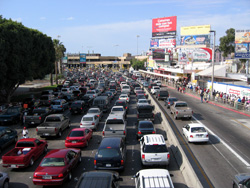
Where
two worlds meet: the international border
crossing between Tijuana
and San Ysidro, CA
On the right "la linea", the long line of people patiently
waiting to enter the U.S.A. |
|
These people are called pollos
and normally they pay 1,500 $ to the coyote,
the man who should theoretically help them to enter the U.S.A.
avoiding the border police; in practice, they are often
abandoned in the desert without food or water.
Recently, owing to the fact that American people hate pollos
and accuse the government to do nothing to fight illegal immigration,
this furious hatred has led to the birth of Minutemen.
This illegal association, which was born in Texas, is composed by
volunteers that hunt and arrest without permission
Mexican immigrants on the border.
|
|
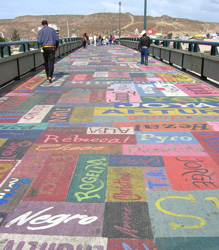
The
long bridge on the river Tijuana, linking the border with downtown
Tijuana |
Only
few miles separate the richest American State and the most violent Mexican city, but these two cities could not be
more different: one symbolizes the modern and technological society
and the other is a shrunken Third World
.
If it rains in San Diego, the rain will only soak you; in
Tijuana you could die: last year 200 people, who lived in unsafe huts in the
suburbs of the Mexican city, drowned.
On Saturday night in Avenida Revoluciòn, one of the main streets of
Tijuana, you can buy everything: coca, tacos, souvenirs, stolen autos, sex,
false visas, Cuban cigars.
In
fact this border city is the capital of drug, criminality and
violence: in the year 2000 there were 52 murders in
San Diego
, in
Tijuana
drug traffickers killed a person every day. |
|
Ramon and Beniamin
Arellano, the two main bosses of drug traffic are the main
responsible of the majority of drugs which enter the U.S.A and they
are wanted by the F.B.I. “Traffic” is called the film about
drug traffic, which was nominated for five Oscars: it is set in Tijuana, but it was never shot in this city: too
dangerous.
|
|
Tijuana’s
economy is strictly connected with San Diego, owing to the fact that
the American city has a lot of advantages buying goods made in
Tijuana at a very low price: for instance, a Mexican worker receives
10 $ per day, while the minimum guaranteed wage in the U.S.A is 4 or
5 $ per hour.
All things considered, it is not difficult to understand the main
reasons why a lot of poor or rich Mexicans move to the States, where
they can find a remunerative job, no corruption and most of all,
they have the right to a safe life.
Moving
to
America
, they bring their culture, their traditions, their language with
them; especially in
San Diego
, most of the teenagers have a peculiar Mexican-American daily
routine.
Every
day they get up at 6 o’ clock in their bedroom full of
American pop singer posters. |
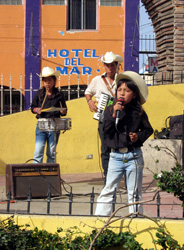
Tijuana
street singers |
|
They put on a pair of blue jeans which
they have bought at
Horton
Plaza
shopping mall the weekend before and they rush to the kitchen where
they quickly eat a tortilla and they drink a glass of apple juice. |
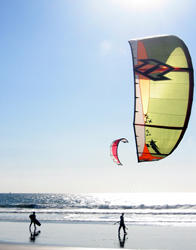
Kite-surfers
on one of San Diego's beaches |
After that they go to school where they speak English during the
lessons and Spanish with their friends. When they come back home, at
lunch they eat tacos with chilli and they spend all the afternoon
surfing the Internet and listening to Mariachi, the typical Mexican
folk-music.
At
weekends, after going to church, they love surfing in the Ocean,
like every other Californian, going shopping and obviously giving
barbecues on the beach where they dance Cumbia.
They really like the American way of life but to the question: -
Will
you ever fall in love with a Yankee? – they are sure that it would
never happen, because they traditions, values and characters are too
different.
|
|
Since they were born, they have always had the American
dream but now, living in California, they are proud to have Mexican roots and they are very jealous of
their culture.
|
|
ADVENTURERS ...
IN THE DESERT
by
Irene Mistro |
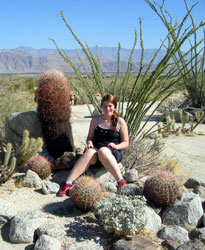
Irene
surrounded by some beautiful Ferocactus,
which thrive in the desert.
Behind her, there's an Ocotillo. |
Anza
Borrego Desert State Park is the largest state park in the Southwest,
covering
600,000 acres
from the edge of the coastal mountains east to the Salton Sea and
south almost to the US/Mexico border, and equals the more famous
national parks further north for varied, unspoilt desert scenery.
This state park remains one of the few places in the country where
open camping is permitted.
If
you want to spend some nights in the desert you just have to respect
some guidelines, useful to preserve the desert environment.
The park offers many other programs. You can join a Volunteer
Naturalist’s presentation at the Visitor
Center
or take a hike with a ranger or take a nature walk, which offers you
the chance to explore the natural features of the Park.
The high country offers plenty of trails. |
|
Away
from the hills, most of the park is desert - covered by densely
growing cacti in some areas but with bare rock and eroded badlands
in others, through which run numerous narrow, slot-like canyons and
other interesting rocky features.
|
|
Borrego
Palm Canyon Trail is one of the most famous trails of the park: it
leads to a cool shady palm oasis. This rocky trail is three miles (about
5 km) round-trip and takes a minimum of two hours.
Walking there you can see the desert’s flora and fauna.
For example you can see plants such as Ocotillos, Chollas, Smoke
Trees, Agaves, Creosote Bushes and Palo Verde Trees.
The ocotillo is a tall, spindly plant which can be found almost
everywhere in the Park.
When in bloom it may look like a candle with spikes of the red
flowers flaming at its tips.
In the Park you can see many species of cholla (pronounced choy-ya).
Soma cholla reproduce by dropping joints that look like spine balls.
The smoke tree is a small tree with gray-green foliage and the
agave, also known as century plant, is famous for the fact that it
blooms only once in its lifetime. |
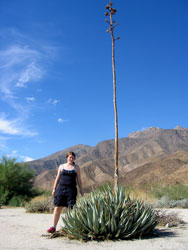
A
blooming agave |
|
The
creosote bush has small white fuzzy seed balls, oily leaves and
yellow flowers; and the Palo Verde tree has chlorophyll also in its
trunk so it can keep growing strong even when it is too dry to
support leaves.
|
|
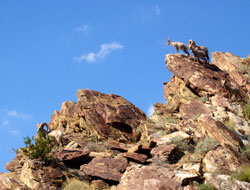
A
group of Bighorn Sheep |
All
these plants are well adapted to the desert environment.
What about desert’s fauna? Here you can see roadrunners (the
famous Beep-beep), coyotes, black-tailed jackrabbits,
pumas, rattlesnakes and so on… and also the peninsular Bighorn
Sheep.
The
park name is derived from a combination of the name of Spanish
explorer Juan Bautista de Anza and the Spanish word "Borrego,"
referring to bighorn sheep.
|
|
And
now, some tips for a safe trip in the desert:
- carry
water and drink it!
- prepare
yourself: carry protective clothing, sunscreens, hat, a good map,
extra food and water;
- and
if you see a snake, leave it alone! |
|
|
SAN DIEGO
ZOO: AMPHIBIANS, BIRDS,
MAMMALS AND REPTILES WELCOME YOU TO ONE OF THE BIGGEST
AND MOST BEAUTIFUL ZOOS IN THE WORLD
by
Anna Gambardella e Alice Simioni |
|
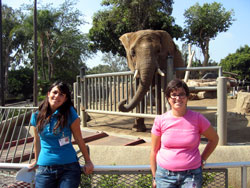
Anna
and Alice in the company of elephants |
The
zoo is huge, so you may need a map or even better a Californian
friend as a guide, who can introduce you to all the secrets of the 5
continents and their wildlife.
Walking
around you can see tigers living in reconstructions of their natural
habitat, the Asian rainforest, orangutans eating calmly and rare red
apes playing on a special wood structure.
|
|
Walking
further, until the North Pole, you can have a look at big polar
bears playing in the water or having a rest under the Californian
sun; if you visit the zoo on the “Snow Day”, you can
admire a very special snowfall in
San
Diego
,
which allows the bears enjoy their own natural habitat for the day.
|
|
After
a few minutes you meet birds, such as the bold eagle, the symbol of
the
USA
which stares at you with its serious eyes and you may be lucky and
see a terrific condor ready to fly with his huge wings!
Of
course you can meet new, peculiar animals such as the okapi, which
comes from the Ituri forest and was unknown to Western people until
1901. It is a shy animal, that lives hidden in the rain forest and
is afraid of people.
The
okapi looks like a zebra but is the only living relative of the
giraffe.
|
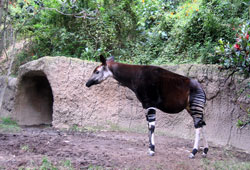
Have
you ever seen an okapi? |
|
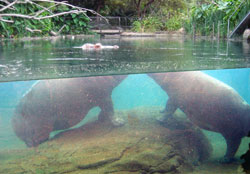
Sleeping
Hippos |
Not
everybody can spy two hippos while they are sleeping underwater or
taking a photo of a sweet panda having a rest on a tree.
And
near the pandas, you can discover the mysterious takins. We know
very little about them, because they live all their life hiding in
the chinese fog.
And
for the braves.... Reptiles!
The
most curious and peculiar?! The californian kingsnake, a two-headed
snake, difficult to find in the wild, because it needs special cures
and because they have many enemies.
|
For
those who likes peculiar things, here is the shingleback, a strange
animal which has head and tail shaped in the same way to confuse
predators!
Animals
in captivity have to be physically and also emotionally well, so the
zoo is trying to improve these aspects.
For
instance it seemes strange for a uniformed visitor, to see a polar
bear living in
San
Diego
in a warm climate. The usually picture that comes to your mind, when
you think of polar bears, is an environment of snow and ice. |
|
But in
fact, the polar bear can be found also in the Tundra. The Tundra is
a dynamic ecosystem, that experiences many changes during the summer
months. In June, July and August there are periods of warmth, in
which the plants grow. So the polar bear doesn’t feel completely
out of place, and enjoys his life also in
San
Diego
,
even with their normal heavy winter coat and the thick of blubber.
To
create the perfect environment, the water in their pool is
constantly chilled to 55-60 degrees Fahrenheit (12-15 degrees
centigrade), to allow them refreshing dips.
|
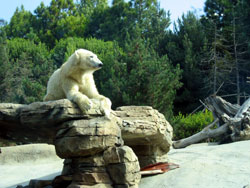
A
polar bear enjoying ...
Southern California's sun |
|
FAKE
TREES? WHY??
Also
the orangutans need special attention. They are very intelligent and
sensitive animals, and suffer if kept without mental challenges.
|
|
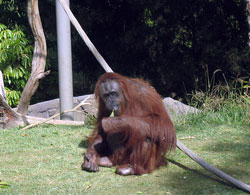
An
orangoutan ready to climb a fake tree |
To
allow them to keep up their normal behaviour of tree climbing and
nest building, the San Diego Zoo decided to put fake trees in their
cage, to make them feel more at home. “Why fake trees?” is the
question that many ask. The answer is very simple: The Orangutans
are used to climbing every night up in the tree, building everytime
a new nest and eating leaves, too. Live trees were simply unable to
survive this treatment. The new fake trees are designed to be very
durable, and so the Orangutans can enjoy their usual behaviour even
in captivity.
|
PANDA
PROBLEMS
Another
“guest” in the zoo who needs special treatment is the Panda.
The
San Diego Zoo is studying pandas, trying to indentify their
nutritional needs, their way of communicating with each other, and
how it is possible to hold them in captivity as healthily as
possible. There are very few pandas ever born in captivity, so
the zoos are trying to find out how to change this.
|
|
The San Diego
Zoo is particularly successful: a new baby panda was born last
September, and visitor can watch him on a screen.
Today
on the Earth there are only 1600 giant pandas left, and so saving
them from extinction and keeping them away from human interference
are real challenges.
Pandas
eat only bamboo leaves. But the trouble with bamboo is not only that
the pandas are very choosy and don’t eat all the different
varieties, but also that this plant grows very slowly. And once it
is grown, all the bamboo in an area will be in bloom and later die
at exactly the same time.
|
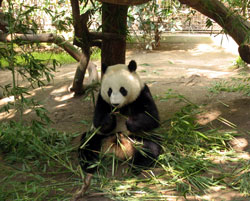
Yummy
Californian bamboo |
|
This
means, that the panda then has to move to another area, where he can
still find edible bamboo. But, unfortunately, the growing population
of
China
is occupying many of these areas, so finding food is becoming harder
and harder for the few remaining wild pandas.
Another
very big problem for those trying to save the panda is that their
breeding season, the time when a male will go and search for a
female to mate with, is very, very short. If then, the few panda
females give birth, they will have a maximum of 2 cubs at a time.
And that is not enough: These cubs are completely dependent on their
mother for a long time, and so their chances to survive are not very
high. |
|
"Any
species is an irreplaceable marvel, equal to the works of art
which we religiously preserve in museums" Claude
Levi-Strauss |
|
|